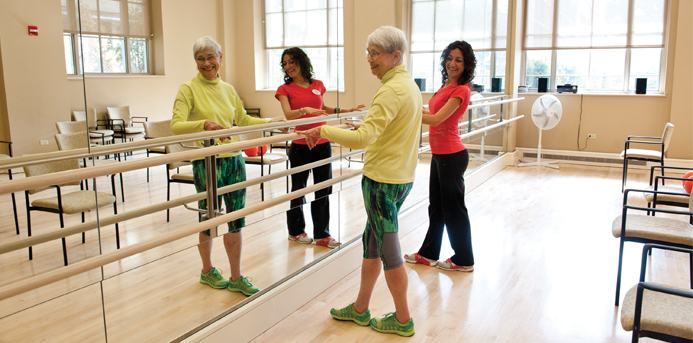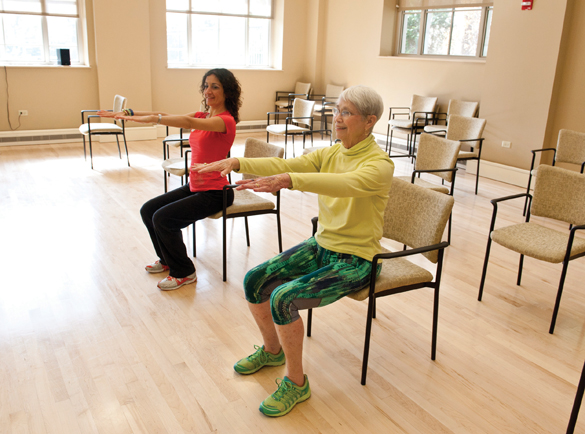While exercise is important at any age, it takes on special resonance for older adults.
Exercise can have a dramatic impact on quality and length of life, helping to maintain strength and mobility and allowing for independent living.
In a recently released University of Florida study of older adults, exercise was proven to keep participants mobile and active, rather than housebound. The Lifestyle Interventions and Independence for Elders (LIFE) study proved that exercise is an important component for maintaining mobility, which in turn keeps people independent and engaged with others. The most important takeaway? It is never too late to start moving.
The Centers for Disease Control (CDC) recommends healthy older adults partake in 150 minutes of moderate-intensity aerobic activity (i.e., brisk walking) every week, and muscle-strengthening activities that work all major muscle groups (legs, hips, back, abdomen, chest, shoulders, and arms) two or more days a week. This works out to about 20 minutes per day, and the CDC adds that exercise can be broken up into 10-minute sessions, making it even more doable.
“Older adults who exercise are healthier, stronger and happier,” says Dr. Victoria Braund, M.D., Geriatric Medicine specialist at NorthShore University HealthSystem and Medical Director at Mather LifeWays.
Dr. Braund emphasizes the following benefits of exercise in older adults:
- Reduced pain and stiffness in the body
- Reduced risk of falling
- Delayed onset of dementia and Alzheimer’s
- Possible aid for disease prevention
- Improved mood
- Slowed muscle and bone loss
- Possible improvement of health conditions including
- Arthritis, diabetes, and heart disease
- Increased energy levels
- Improved sleep
Dr. Braund stresses the old adage “use it or lose it” when it comes to her patients and exercise. She recommends walking, swimming, water aerobics, exercise videos, dance classes, Tai Chi and even gardening.
At age 84, Ragnhild (Ronnie) Seiler-Raskin swims for 35 minutes five days a week at the North Suburban YMCA. Ronnie swims the front and back crawl, sidestroke, and uses a pool noodle to ride the bike in the water. “Swimming lifts my spirits and is relaxing,” she says. “When I swim, nothing hurts!” Ronnie enjoys the community of active older adults at the Y, which offers many classes for her age group. She still drives, walks her dog, enjoys visiting with friends and family, attends theatrical performances at Glenbrook North High School, and strolls with her daughter in the Ryerson Woods in Riverwoods and the Chicago Botanic Garden in Glencoe. While she has had several health issues, her active lifestyle has allowed her to recover and get back to the business of living.
5 Exercises to Do Today
Walking: Anita Tomasevic, Life Enrichment Manager at Mather, says “Walking is the best exercise, increasing cardiovascular fitness, reducing body fat, strengthening bones, and boosting muscle power and endurance. Walking is free and doesn’t require any special equipment or training.”
Squats: Squats help preserve physical function and are good for strengthening hips, thighs and buttocks, which are all key for walking, jogging and climbing stairs.
Crunches: Forward crunches on a chair help maintain core muscles, which are the muscles that support the spine and abdominis muscles. A strong core helps preserve stability and increases balance, which not only helps prevent falls, but can also eliminates back pain.
Tandem stance for balance: Standing while supported with feet hip distance apart, place one foot in front of the other, then return to start. Repeat with the other foot in front. Repeat, adding a turn of the head to the right, back to start, then to the left, then back to start. Maintaining balance helps prevent falls.
Kegels: Kegel exercises with a ball can improve urinary incontinence that might come with age. Kegel exercises can improve bladder control, which allows older adults to maintain their lifestyle.
For older adults, it’s never too late to start. For those with no existing health conditions, begin with a short walk and the exercises above; for those with existing conditions, check first with your physician to encourage and guide your exercise program. Tomasevic points out that the older adults she trains “say they wish they’d taken care of their bodies sooner.” Don’t wait.


